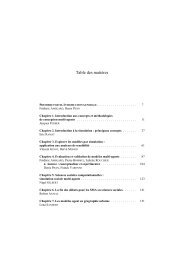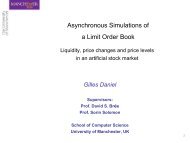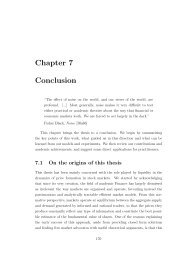market architecture of selected stock exchanges in ... - Gilles Daniel
market architecture of selected stock exchanges in ... - Gilles Daniel
market architecture of selected stock exchanges in ... - Gilles Daniel
Create successful ePaper yourself
Turn your PDF publications into a flip-book with our unique Google optimized e-Paper software.
31“trad<strong>in</strong>g imbalance” 27 is a call auction, which determ<strong>in</strong>es the reopen<strong>in</strong>g price, afterwhich cont<strong>in</strong>uous trad<strong>in</strong>g proceeds.3.5 Electronic vs. Floor Trad<strong>in</strong>gThe <strong>market</strong> <strong>architecture</strong> designates the set <strong>of</strong> rules govern<strong>in</strong>g the trad<strong>in</strong>g process.One attribute affect<strong>in</strong>g the <strong>market</strong> structure is the degree <strong>of</strong> automation. Marketsvary considerably <strong>in</strong> the extent <strong>of</strong> automation. Two opposite extremes can beidentified (see Table 12): centralized floor trad<strong>in</strong>g (= open outcry) and decentralizedelectronic trad<strong>in</strong>g (Madhavan 2002).Table 12: Key Institutional Differences between Floor and Electronic Trad<strong>in</strong>gKey Institutional Differences between Floor Trad<strong>in</strong>g and Electronic Trad<strong>in</strong>gInstitutional Feature Floor ElectronicLocationTrad<strong>in</strong>g takes place on the trad<strong>in</strong>g floor <strong>of</strong>the exchangePresence at the exchange not obligatoryIdentity <strong>of</strong> counterparty Known before the trade Usually revealed after the deal is closed although afew <strong>exchanges</strong> display broker identity beforeTransparency <strong>of</strong> availableliquidityUsually only the best bid and <strong>of</strong>fer is knownto traders before order<strong>in</strong>gUsually the top-five best buy and sell prices(sometimes the whole book) are displayed ontraders’ screensPlacement <strong>of</strong> orders Via the floor traders Sent to a central computer, which places the order<strong>in</strong> the order bookSpeed <strong>of</strong> match<strong>in</strong>g tradesor immediacyOperat<strong>in</strong>g cost and orderprocess<strong>in</strong>g costsSpeed and cost <strong>of</strong>settlementOrder bookTrades are matched manually based on anopen-outcry system and take from 10seconds to several m<strong>in</strong>utesHigherSettlement is <strong>of</strong>ten paper-based, with aconsiderable lagOften does not exist; quotes are valid only aslong as “breath is warm”Source: Ja<strong>in</strong> (2005) and own modificationTrades are matched automatically by a computeralgorithm with<strong>in</strong> one secondLowerUsually faster, dematerialized settlement andlower costsMatches or accumulates customers’ limit orders;quotes are valid until withdrawnModern <strong>stock</strong> <strong>exchanges</strong> compete aggressively for trad<strong>in</strong>g activity and <strong>in</strong>vestor<strong>in</strong>terest. Therefore, the <strong>exchanges</strong> <strong>in</strong>troduce technology to enhance their <strong>market</strong>s. Inthe past few years, technology has accelerated the speed, with which orders aresubmitted and translated <strong>in</strong>to trades. Moreover, it has improved communication, andthus <strong>in</strong>formation. Speed and connectivity are the most obvious arguments for thegrowth <strong>of</strong> technology support<strong>in</strong>g order rout<strong>in</strong>g as well as clear<strong>in</strong>g and settlement.27 “Trad<strong>in</strong>g imbalance” is accord<strong>in</strong>g to Campbell (1988, p.305) every situation where it comes to anexcess <strong>of</strong> <strong>of</strong>fers to buy or sell an asset







